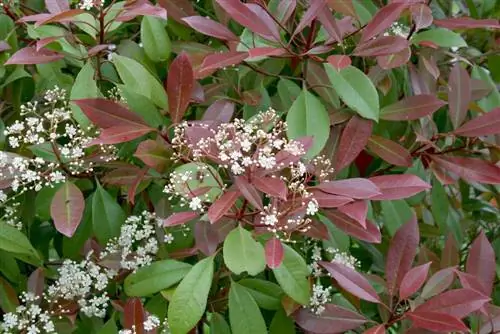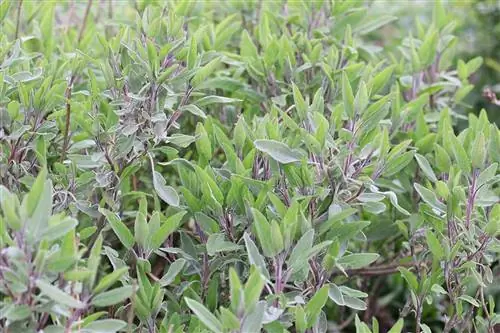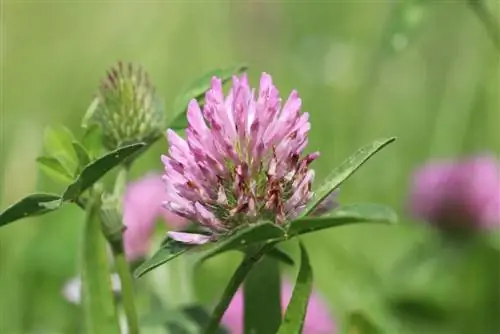- Author admin [email protected].
- Public 2023-12-17 03:39.
- Last modified 2025-01-24 12:45.
The loquat 'Red Robin' is one of the most beautiful evergreen trees and is characterized by the color change of the foliage. The intense red shoots of the young leaves are already impressive in spring. In May and June, the Photinia Fraseri presents itself perfectly with its white flowers. After flowering, red berries decorate the ornamental shrub. With a size of up to three meters, the red loquat is not necessarily one of the small deciduous trees. The plant grows loosely upright and bushy wide.
Location
This colorful gem prefers a sunny location. She also feels comfortable in a partially shaded spot. A shady location is less suitable. If the plant is in the shade, fewer flowers and therefore fewer fruits will form. In addition, the foliage color decreases. The loquat cannot tolerate strong winds at all. A protected location is therefore recommended. Caution! The red fruits are poisonous. Therefore the plant is not suitable for families with small children.
Substrate
The evergreen sweetheart has no special demands on the soil. In principle, almost any garden soil is suitable. Whether acidic, neutral, calcareous or alkaline, the medlar can cope with almost any soil. A humus-rich, well-drained soil contributes to the well-being of the plant. However, the soil should be low in nutrients, not too wet and not too dry.
Tip:
Dense and heavy soil can be loosened with sand or gravel. This makes the soil permeable and overflowing water can flow away unhindered.
Watering and fertilizing
Watering and fertilizing the red loquat is also quite easy:
- The attractive ornamental shrub thrives on moderate watering.
- After replanting, you should always water abundantly.
- Otherwise, only water when the top layer of soil is completely dry.
- This applies to potted plants as well as to colleagues planted in the garden.
- If the Photinia Fraseri 'Red Robin' is cultivated as a container or potted plant, excess water in the saucer or planter should be removed.
- The ornamental shrub doesn't like waterlogging at all.
- Commercial fertilizer can be used for fertilizing.
- Give long-term fertilizer (depot fertilizer) in spring
Tip:
To protect the plant from fungal diseases, the leaves should not be wetted when watering.
Wintering
As an evergreen ornamental shrub, the red medlar is hardy down to minus 20 degrees in mild winter areas. However, in long-lasting frosts, the deeper layers of the ground can also freeze. This means that the tree can no longer absorb water, which results in it drying out
The most common reasons for damage to the plant are winter sun, rapid thawing and rapid freezing.
- Winter sun should be avoided if possible.
- Young Photinia Fraseri are not sufficiently hardy and need special protection.
- Freshly planted red loquats outdoors are also sensitive to frost.
- Hardiness increases with age.
- Overwinter the plant in a shady, frost-free location.
- A sheltered place on the house or garden wall is recommended.
Even in winter, water is done on frost-free days when the top layer of soil is dry. Waterlogging should also be avoided in winter. If temperatures fall below -5 °C, potted plants need adequate winter protection. Without winter protection, the pot ball can freeze relatively easily.
To protect the plant, the bucket is first placed on feet so that excess water can drain away. To protect against icy temperatures, the bucket is loosely wrapped with fleece. Furthermore, bubble wrap provides additional protection. If you fill dry leaves or straw between the fleece and the bucket, you can offer your pet optimal winter protection.
If the loquat is used as a hedge, it is important to also protect the above-ground parts of the plant from the winter sun with fleece or fir branches. Otherwise the root area will be covered with leaves. If the temperatures rise above 0 °C again, the fleece is removed. This gives the plant enough light and air again.
Cutting

'Red Robin' grows quite quickly and still only needs pruning once a year. The optimal time is the end of June, after flowering. If necessary, either only thin out a little or cut back heavily. If the distinctive hedge plant is cut at the end of the winter, new shoots will be formed, but hardly any buds will form in the coming year. Pruning is not necessarily necessary for solitary plants. When pruning, not all flower spikes are removed, otherwise new fruits will not form. The fruits in particular decorate the garden in the winter months. Basically, all shoots are only slightly shortened from the middle. This ensures that enough light reaches the center of the bush and encourages the leaves to sprout. The result is a shapely, dense hedge.
Diseases and pests
Aphids
Sometimes it can happen that aphids attack the red loquats. Shoots and young leaves are particularly affected here. Nettle broth helps with pest infestations. Severe infestations are combated with preparations made from potash or rapeseed oil. As a preventive measure, the plant can be sprayed several times in spring with a garlic infusion.
Leaf Tan
Leaf browning is caused by fungi and appears as red and black spots on the leaf. The fungal disease is combated with a fungicidal preparation based on copper sulfate. Plant-strengthening agents such as horsetail extract help preventatively.
Bigmouth Weevil
It also happens that the black weevil spreads on the leaves of the loquat. Root collars and roots can also be damaged by the larvae. To combat them, collect the beetles. Irrigation water containing nematodes eliminates larvae.
Frequently asked questions
How do the falling leaves of the cotoneaster explain?
Falling leaves are usually a sign that the attractive ornamental plant is kept too wet. Loquat is sensitive to waterlogging. Therefore, watering should only be carried out when the top layer of the substrate is dry. Especially if the plant is grown in a pot. Excess water in the saucer should be removed immediately.
Can the Photinia Fraseri 'Red Robin' tolerate strong wind as a hedge plant?
In summer, wind is not a big problem. However, the leaves can be damaged by prolonged dryness and wind. In the cold winter months, the loquat cannot tolerate strong winds. She dries up. Initially the leaves are affected and over time the shoots dry out considerably. Therefore, windy locations are not suitable.
Can loquats planted in autumn still be fertilized?
The Photinia Fraseri is usually supplied with nutrients through fertilizer from spring onwards. Because, like other plants, the medlar prepares itself for the cold season in autumn. Fertilizing at this time stimulates growth and the plant cells become soft. The consequences are frost damage.
What you should know about Photinia fraseri 'Red Robin' coming soon
Care
- The loquat can be planted outdoors or in a pot as a single plant, but it is also often used as a hedge plant.
- It needs a place where it is sunny to partially shaded and where the soil contains lots of nutrients.
- She doesn't like strong winds, so a somewhat sheltered spot is ideal.
- Its water requirement is only moderate, so it doesn't need to be watered too often.
- To avoid waterlogging, which a loquat cannot tolerate, a very heavy and dense soil can be loosened up slightly with gravel or sand.
- The Photinia fraseri is hardy, but young or newly planted plants should still be provided with root protection in the first winter.
Attention:
However, this only applies to varieties that are evergreen. Some varieties of cotoneaster shed their leaves in winter and are insensitive to frost from the start.
Advantages
- The cotoneaster blooms in May and June and then forms panicles with many small white flowers.
- Red fruits form in autumn, which are poisonous to humans but are often eaten by birds.
- As long as they are not eaten by the birds, these fruits remain on the bush until winter.
- The Red Robin variety is particularly popular, reaching two to three meters in height and is therefore often used as a privacy screen.
Tip:
To make the hedge opaque, it is best to plant two to three plants per meter. However, this variety should best only be planted in a protected location and also receive winter protection.
Cutting
- A loquat grows up to three meters high and is also quite wide, so it may need to be cut back.
- The best time for this is after flowering, i.e. around the end of June.
- Then the shrub can be thinned out and shortened a little as needed, but it can also be cut back heavily.
- The plant tolerates pruning very well and grows up to 50 cm per year in a favorable location.
- Because the leaves of the Photinia can quickly be damaged with an electrical device, it is best to cut them by hand with hedge trimmers.






